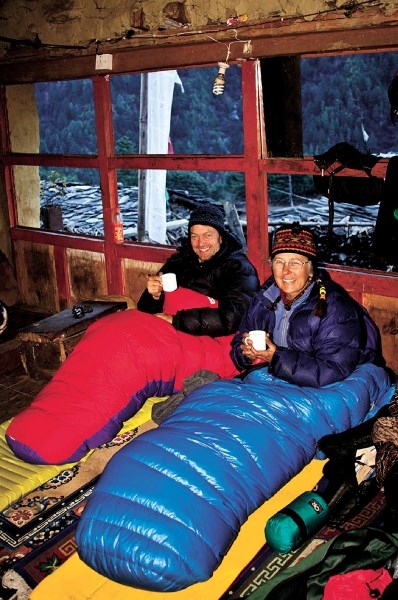“A lot of us don’t know what we want to do with our lives until adulthood,” said Pat Morrow, addressing nearly 200 people at Banff’s Whyte Museum of the Canadian Rockies on Feb. 23.
“I was lucky. When I was a teenager, I knew I wanted to be a photographer.”
When he left the Banff Centre’s photography program in 1975 to pursue freelancing full-time, Morrow also knew, “my camera would be my ticket to see the world.”
At only 19, Morrow attempted his first serious climb, a winter ascent of Mount Assiniboine, with two friends. Caught by darkness descending from the summit, they dug a snow cave with their hands and ice axes, huddling overnight in -32 C temperatures. The following day, they completed a full traverse of the mountain.
That adventure taught him many lessons about surviving in cold, dangerous places, experience that helped him become the second Canadian to reach Mount Everest’s summit as part of Canada’s 1982 expedition and, in 1986, to become the first person to climb the Seven Summits, the highest point on each continent.
Speaking at the Whyte as a guest of the Exposure photography festival, Morrow also recently received SAIT’s Distinguished Alumni Award. A SAIT journalism student in 1973, Morrow was recognized for his Seven Summits accomplishment, and for the significant body of award-winning photographs, articles, books and films he and his wife Baiba have produced documenting the cultures and natural environments of some of the world’s most remote, exotic places. He was also commended for co-founding the Purcell Wilderness Conservancy in the early 1970s, working to preserve his home mountains, the Rockies and Purcells.
Estimating he’s spent an accumulated 15 years in sleeping bags, plus many more on friends’ living room floors, Morrow said many today view climbing Everest as the ultimate achievement.
“There are many people today who believe climbing Everest is the ultimate achievement, and it probably is for those who pay large sums to be guided up the mountain – leaving all the decision-making, route-setting and load carrying to someone else – then join the rubber chicken circuit to give ‘motivational’ talks to corporate audiences who don’t know the difference,” Morrow said.
“For me, climbing Everest wasn’t merely an entrepreneurial end in itself, but served a higher purpose – it was a stepping stone to nearly 30 years of leading my own expeditions and filming projects in the great ranges of the world.”
Crediting some early climbing partners who taught him to “live high on a few bucks a day,” Morrow said in today’s privileged age of flying half-way around the world in a matter of hours, often, “the irony is, the farther we travel, the less we know.”
Sharing a 90-minute round-the-world journey, Morrow’s images and video clips captured adventures ranging from climbing Antarctica’s Mount Vinson, traversing Japan’s Alps, witnessing an erupting volcano on Russia’s Kamchatka Peninsula, canyoneering in the mysterious slot canyons of Utah and Arizona and capturing Irian Jaya’s Dani tribesmen modelling their signature penis gourds.
Along the way, Morrow also co-founded Adventure Network International, the first travel logistics company to help adventurers heading to the Antarctic interior.
“I’ve never taken my vocation too seriously,” Morrow admitted. “My primary focus has always been to see the world. The secret to being an adventure photojournalist is not to go into too much debt. All you really need is a camera and a couple of lenses. But in order to pay the bills, you’re going to have to come up with the goods, which means developing trust in the publishing and broadcast world by delivering professional quality content consistently, and on time.”
Expressing gratitude for having been invited to shoot video or stills on 16 high altitude expeditions since Everest, Morrow said he and Baiba have spent 500 days trekking in the Himalaya, often re-connecting with old friends.
“Tibetan Buddhism, with its compassionate approach to life has had a tremendous influence on my life,” he said.
Admitting skiing is his greatest passion – he’s skied on 10 of 22 high altitude expeditions, including down sand dunes on the Tibetan Plateau and twice from Mount Logan’s 5,959-metre summit – Morrow said his second favourite part of Canada is the Yukon, where he’s explored the St. Elias interior on four expeditions.
He concluded with images from favourite places in B.C.’s Purcells –where the Morrows relocated in 2007 after living in Canmore for 20 years – and praising revered Austrian-born mountain guide Conrad Kain who settled there. He added his current passions include active involvement with Wildsight, a non-profit group dedicated to protecting wildlife and wild places in the Columbia and Rocky Mountain regions, and introducing teens to the mountains.
“As time goes by, I feel more and more strongly about advocating for getting kids into the wilderness,” Morrow said, “These experiences help nurture an attitude of stewardship. And what better way to honour Kain?”




